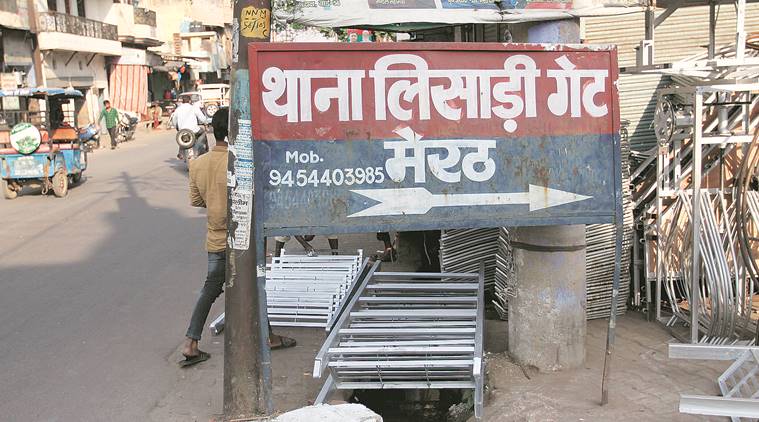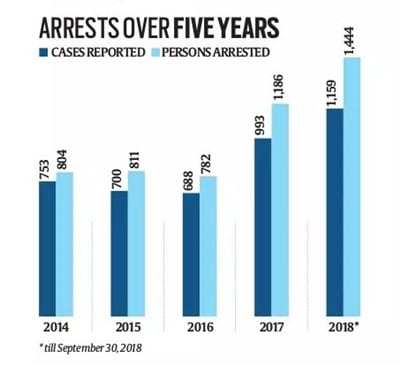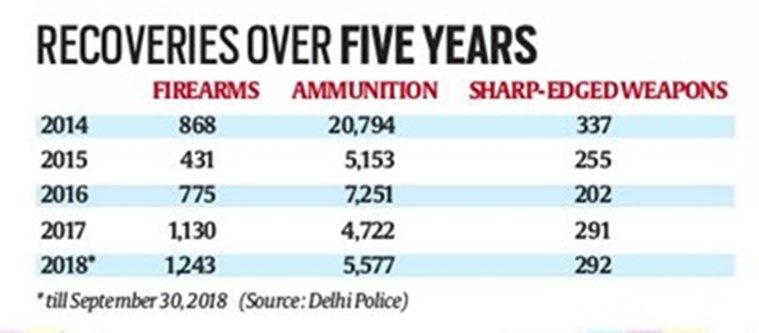 At Meerut’s Lisari Gate, where police arrested three men and busted an arms racket. (Express photo by Gajendra Yadav)
At Meerut’s Lisari Gate, where police arrested three men and busted an arms racket. (Express photo by Gajendra Yadav)
Murmurs about what happened on the evening of October 8 in Meerut’s Lisari Gate have still not subsided. It was a scene straight out of a film, described a resident of gali number 18/2. A three-hour raid by policemen in plain clothes of an 8×6 room, hidden in the basement of a house, led to the recovery of 18 country-made pistols and raw material.
As residents watched, stunned, three men from Bihar’s Munger district were arrested by the Delhi Police Special Cell. They had rented the room a month ago. “They rarely got out of the house, we didn’t notice anything suspicious. During the day, there was some construction going on inside the house. We found out on the night of the raid that it was linked to what they were doing. All night, policemen roamed around in their gypsies,” said a neighbour.
For years, the gun route to Delhi has started at Munger, infamous for the manufacture of illicit firearms. Pistols, often referred to as katta, tamancha or aslaha, are then sold across north India, including in the capital. The raid in Meerut, however, is a reflection of the changing modus operandi of the scores of gangs trying to creep into the arms business.
“We have noticed this during the last few recoveries. Due to the increased crackdown on the old Munger-Delhi route, the manufacturing process has shifted closer home. They are using small factory-like setups in Delhi-NCR instead. They get the raw material from Munger, and assemble the weapons in a rented accommodation near Delhi before selling it,” said a police officer.
This, the officer explained, is worrying because it is harder to intercept gun parts making their way to the city than entire weapons. During the October 8 raid, police had recovered springs, iron cutters, shafts, hammers and unfinished firearms. “Gun barrels and springs made in Munger are considered reliable by criminals. These barrels can fire 15-20 rounds in one go, while shafts made elsewhere fire two-three rounds and run the risk of backfiring,” the officer said.
Orders from the top
Though he was carrying a licenced weapon, the video of a former MP’s son brandishing a gun and threatening a man and a woman outside Delhi’s Hyatt Regency hotel has reignited the debate, and worries, on how easy it is to get one’s hands on a weapon. Similar concerns were aired when former JNU student Umar Khalid was assaulted outside the Constitution Club by a gun-toting man, and when sophisticated weapons were recovered following an encounter in June, in which Delhi’s most-wanted gangster Rajesh Kandela alias Rajesh Bharti was killed. A comparison of the last four years also shows a steady increase in the number of firearms and ammunition recovered in the capital.
At a crime review meeting held at the Delhi Police headquarters recently, Delhi Police Commissioner Amulya Patnaik asked “all 14 DCPs to chalk out effective strategies to create a deterrent impact” on “robbers, snatchers and criminals carrying firearms”.
At Meerut’s Lisari Gate, the 8×6 room had been rented to three men from Munger for an exorbitant Rs 15,000. The current rent for such a room in the area: Rs 2,000-3,000.
 The owner of the house, Furkan, was arrested by Meerut Police for “renting his house for illegal activities” as well as under the Arms Act. SHO (Lisari Gate) Raghuraj Singh said that “in a few days, the pistols would have been ready and sold in the market” — mostly areas bordering Delhi and western Uttar Pradesh.
The owner of the house, Furkan, was arrested by Meerut Police for “renting his house for illegal activities” as well as under the Arms Act. SHO (Lisari Gate) Raghuraj Singh said that “in a few days, the pistols would have been ready and sold in the market” — mostly areas bordering Delhi and western Uttar Pradesh.
At Furkan’s house, his wife and four children were unwilling to talk about what had happened. “We only gave a room inside our house on rent; we didn’t know what they were up to,” his wife said. Singh said gun-makers often zero-in on “innocent” people desperately in need of money.
DCP (Special Cell) Sanjeev Yadav sought to shed light on another aspect of the evolving gun trade: “Gun experts from Munger and MP’s Khargone help youths set up such factories in western UP because the demand in such places is high and they are close to Delhi, which makes for good business.”
Yadav said their counterparts in UP crack down on illegal firearms routinely, and “two such units were busted in Meerut recently”. Another officer said hotspots for such small units include Baraut, Kairana, Agra, Aligarh, Shamli, Muzaffarnagar and Ghaziabad.
Police said once an arms smuggler is arrested, they try to track down the source and the destination. DCP (special cell) P S Kushwaha said, “We are not limiting ourselves to recovering weapons, we are also looking at where they are manufactured and how they reach Delhi.”
Amping up
According to Delhi Police figures, between January and September this year, 1,243 firearms and 5,577 ammunition were recovered. Last year, the Delhi Police had recovered 1,130 firearms and 4,722 ammunition. Till September 30 this year, police had arrested 1,444 persons for manufacture and/or sale of illegal weapons, while the number in 2017 stood at 1,186.
“The demand for firearms has rapidly increased over the last few years as every criminal — big or small — wants to keep a pistol instead of knives or blades. We notice this when we compared figures from 2014 and 2018. In 2014, we recovered 337 sharp-edged weapons, while in 2018, so far we’ve recovered 292,” said an officer involved with the crackdown on illegal firearms.
A key reason why the ‘katta’ is preferred over a licenced pistol by petty criminals is the cost. A licenced weapon can cost up to Rs 70,000, while foreign-made ones go up to a few lakhs. On the other hand, a country-made weapon is priced anywhere between Rs 2,000 and Rs 10,000. Police said that following the Meerut bust, the accused revealed that the pistols were supposed to be sold for Rs 3,000-5,000.

An officer spoke of another worrying trend: illegal arms manufacturers trying to produce more sophisticated semi-automatic weapons, such as .32 bore, .22 bore and .315 bore pistols. In the June shootout with Bharti outside a south Delhi farmhouse, police had stumbled across semi-automatic firearms. Similarly, 9 mm pistols, prohibited for use by civilians, were used in the killing of gangster Monu Dariyapur, following a gang war in April, 2017. Police have, over the years, also recovered carbines, revolvers, a Brazil-made 9 mm Taurus automatic pistol and a .455 bore pistol, used by the American armed forces.
“With the increase in demand of 9 mm pistols, manufacturers have started stocking up. The price ranges from up to Rs 12,000 to Rs 15,000,” said the officer.
Part of the reason such weapons are gaining traction is because country-made ones are known to jam or malfunction. The 9 mm has higher damage, the bullet travels a longer distance, and the cartridges are bigger, an officer said, adding that country-made pistols “account for up to 30-40% of crimes in Delhi, and are used in cases of snatching, robbery, dacoity and homicides”.
As far as licensing goes, unlike in the US, getting one is an onerous task in India. As per the Arms Act of 1959, licence for a gun can be procured only if a person can prove a threat to his life. As per the Delhi Police’s licensing department, about 45,000 persons have licences for their weapons in the city.
Any sophisticated firearm, however, is useless without cartridges. According to police, it is extremely rare to come across cartridges being manufactured illegally. Instead, these are sold illegally. In June, the Special Cell had arrested two people from Delhi’s Sarai Kale Khan, and recovered 1,560 live cartridges. “It was found that the live cartridges were purchased from various legal gun houses in Delhi and UP. The accused had been doing this business for three years, and sold about 1,000 cartridges a month,” said a police officer.
According to police, owners of gun houses have been found to issue cartridges to illegal sellers, but writing it in their register as a purchase by a licenced gun holder. However, the owner of one such shop in Meerut insisted, “We inform the magistrate’s office about every minute detail regarding sale of the arms and ammunition.”
Another mode of smuggling is directly from the ordnance factory, where cartridges are manufactured. An official from the Delhi licensing department said the L-G has asked for routine checks of the 23 shops selling ammo in the city.
Means and the end
While the manufacturing threat has moved closer home, gun smugglers coming from afar still take the tried and tested approach: Come in a car or use public transport. An officer, who has been a part of several operations in which smugglers coming from Munger were arrested, said: “In 2018, a cache of 30 sophisticated firearms was recovered from the CNG cylinder in a car. A year ago, 90 pistols were found hidden inside a cavity in the headlight of a car.”
 While using a bus or a train, criminals keep their bags far away, but not hidden. Sometimes women are roped in so as to not arouse suspicion; other times several buses are changed to make sure they aren’t followed. Still, an evolving police force has meant a harder time for them. “With the help of local intelligence and inter-state coordination, the case workout rate and crackdown on such smugglers has increased. Our officials keep a tab on their movements right from the time they begin their journey. As soon as they reach Delhi, they are arrested,” said DCP Singh.
While using a bus or a train, criminals keep their bags far away, but not hidden. Sometimes women are roped in so as to not arouse suspicion; other times several buses are changed to make sure they aren’t followed. Still, an evolving police force has meant a harder time for them. “With the help of local intelligence and inter-state coordination, the case workout rate and crackdown on such smugglers has increased. Our officials keep a tab on their movements right from the time they begin their journey. As soon as they reach Delhi, they are arrested,” said DCP Singh.
Disposal of seized firearms happens once a year. This year, it was done in May, when over 500 country-made firearms were cut into three pieces at the office of the Nazarat Branch of the Delhi Government’s revenue department. Headed by the divisional commissioner of the revenue department, the Nazarat branch is in charge of disposing case properties where the court has passed a judgment. It looks after seized properties of 218 police stations.
An official said sometimes, the guns being destroyed date back to 1960s and 70s. He added that they also have German, Italian, Chinese and Pakistani firearms, which have been seized in the past and are awaiting disposal. “For disposal of such weapons, we have written to senior department officials for approval,” added the officer. The metal left behind after country-made guns, pistols and cartridges are cut into pieces is auctioned to local scrap dealers through online tenders.
The new modus operandi
-Smugglers look for a safe zone around Delhi, where they can assemble firearms. They take a house on rent for a few months, and pay more than the current rent.
-They get raw material delivered, including springs and barrels. Manufacturing a pistol takes one-two days.
-They then use public transport to deliver the finished products (10-20 at a time), which are hidden in travel bags. They avoid taking the border routes which are under police watch. Sometimes, the guns are smuggled via trucks carrying other material. An associate then delivers the weapon to the customer. On rare occasions when the route is clear, they use private vehicles.
-If the customer approaches the manufacturer directly, the pistol rate is around Rs 2,000- Rs 3,000. When it goes via middlemen, the cost goes up to Rs 10,000 or above.